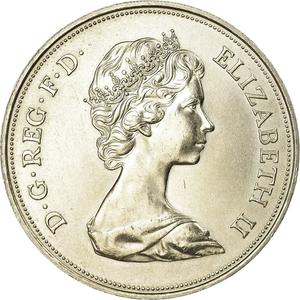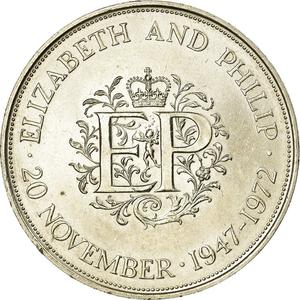The 1972 Silver Wedding crown was minted the year after decimalisation to commemorate the Silver Anniversary of the Royal Wedding between Queen Elizabeth II and Prince Philip, the Duke of Edinburgh; but how much is the coin worth today?
For uncirculated cupro-nickel versions of the coin, you can expect to pay around £1.37 according to the latest values on eBay. The proof version issued in the 1972 coinage set sells for between £20 and £30, and the silver proof version goes for as much as £60 at some coin retailers.
In the rest of this article, we’ll explore the fascinating history behind the coin as well as how rare it is and what versions of it were issued.
Let’s get into it.
1972 Silver Wedding Crown Design
The obverse of the coin features the second portrait of her Majesty. In this portrait, the Queen wears the Girls of Great Britain and Ireland diamond tiara which was a wedding gift.
The reverse design shows the letter EP – for Elizabeth and Philip – with a background of foliage and a figure of Eros in the middle, symbolising the Ancient Greek philosophy of love.
Interestingly, this design does not feature the value of the coin on it, unlike today’s coins.
Are There Any Other Versions Of The Coin?
There were two versions of the coin introduced – the standard cupro-nickel uncirculated version alongside a silver proof version. A third proof version was introduced in the 1972 Coinage of Great Britain & Northern Ireland coin set that was actually issued in 1976.
This is common practice for commemorative coins, as the Royal Mint likes to produce proof versions for collectors to buy alongside the standard version of the coin.
How Many Were Minted?
The mintage figures for each of the versions of the coin can be found below:
| Version | Mintage |
| Cupro-nickel | 7,452,000 |
| Proof Version (1972 Coinage Set issued in 1976) | 150,000 |
| Silver Proof | 100,000 |
It’s important to note that the coins were not issued for standard circulation, as the Crown became much more of a commemorative coin in the 20th century compared to centuries before when it was an ordinary circulating coin that would be used in daily life.
Does This Mean It Is Rare?
Relatively speaking the cupronickel version’s mintage is quite high at almost seven and a half million. Since the coin was highly collectable at the time it is likely that a lot of them remain in possession as well; so it’s safe to assume that this version isn’t very rare.
The proof version that was confusingly issued in 1976 as part of a 1972-dated coinage set had a mintage of 150,000 but was not issued in silver. This is still a very small mintage number and is reflected in the average sale price of between £20 and £30.
The silver version, on the other hand, had a very small mintage of just 100,000 which makes it very rare. This version sells for up to £60 on online coin retailers, which reflects the rarity as well as the silver metal used to create it.
How Do You Tell The Difference Between The Two Versions?
The silver version of the coin was issued in a green case with a certificate of authenticity.
If you don’t have the certificate, then you may need to get in touch with a specialist who can use a special machine to check whether the coin is silver or not.
The proof version was issued in the 1972 coinage set, so you would need to have access to the entire set to differentiate it from the regular cupro-nickel version.
History Of The Coin
The 1972 Silver Wedding Crown coin has a lot of historical value.
First and foremost it was minted to commemorate the Silver Anniversary of the Royal Wedding between Princess Elizabeth and Philip Mountbatten which took place on Thursday 20 November 1947 at Westminster Abbey in London.
The wedding took place just two years after the Second World War, another historic event that has since been commemorated on some newer coins such as the 2005 World War 2 £2 coin.
A few years after the wedding Princess Elizabeth would succeed to the throne becoming Queen following the death of her father, King George, on 5 February 1952.
Decimalisation
Another very interesting topic surrounding this coin is that it was minted in 1972, the year after decimalisation.
Decimalisation had a profound impact on the currency as the sub-units of the pound were changed. Prior to decimalisation, one pound was worth 20 shillings, and one shilling was worth 12 pence meaning one pound was 240 pence.
This is interesting because a Crown had a face value of five shillings before decimalisation, and since the 1972 Silver Wedding crown was the first one to be minted post-decimalisation it had a face value of 25 pence instead.
It was also technically the first commemorative coin of the decimal era; making it clear to see why coin enthusiasts like the coin so much.
It’s important to note that the face value of Crown coins has since increased to £5 in 1990 due to the size and weight of the coin.

